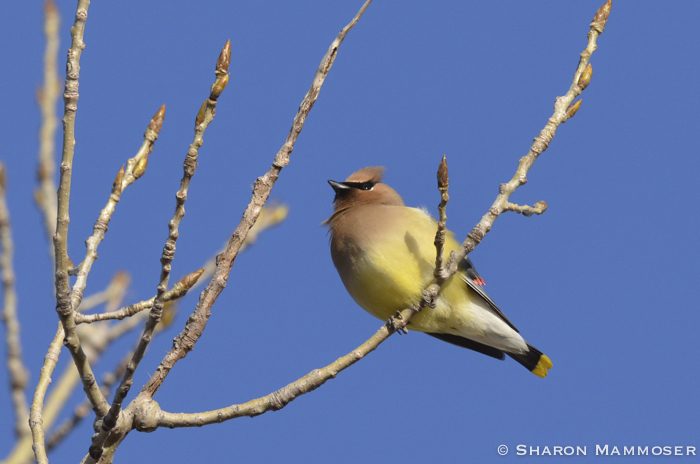Did you recognize the sleek birds in last week’s puzzler as cedar waxwings?

When I was a child growing up in western New York state, I remember one summer when cedar waxwings nested in our yard, some of them tearing apart our clothesline to use for their nests. One nest in our maple tree in the middle of the yard could be seen quite clearly, with its stolen white strands of line making up the simple cup in the fork of two branches. It was very obvious in the tree, not like other nests that blend in and disappear.
At some point that summer an adult cedar waxwing died and I found it, motionless but perfect, on the ground. Having never looked closely at one with binoculars, I was blown away by the beauty of the bird, up close and still in my hand. I remember marveling over the bird’s beauty, wishing I could keep it forever. I loved the feel of the smooth feathers and spent time admiring the perfect row of yellow across the end of the tail feathers. I didn’t know what to do with, but couldn’t bring myself to just leave it on the ground, so instead, put it in a plastic bag and buried it out in the sandbox. Some days later I yearned to see it again, and so, dug it up. Of course by then it did not look the same! Imagine my shock at finding my beloved prize covered in maggots! Horrified, I quickly reburied it. I had never considered what happened to something in nature after it died, but that was a lesson that stuck with me for a long time.
Cedar waxwings take 5-6 days to make their nests and will nest in areas with other pairs of waxwings. The female will sometimes steal material for her nest from the nest of other birds. Though cedar waxwings eat mostly fruit–such as serviceberries, elderberries, winterberries, cherries, and mulberries, like most birds, they will feed their young chicks a regular supply of protein-rich insects and invertebrates.
Cedar waxwings are a little larger in size than a house sparrow, with yellow bellies, tan backs, and a black mask under a distinct crest. Their wing tips look like someone painted them red, adding a dash of yellow paint to the tail before finishing. Through binoculars, they are gorgeous birds that look sleek and elegant.
Ready to test your birding skills a little longer? Weekly puzzler #202 is another bird–see if you can recognize it. (hint: it also has a crest, but is a lot less striking and a lot more likely to be a regular visitor to your bird feeder.)

